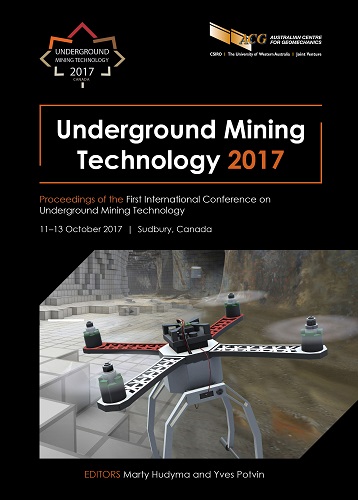Using the single index model to create a short-term mine plan

|
Authors: Maybee, B; Yana, J |
DOI https://doi.org/10.36487/ACG_rep/1710_40_Maybee
Cite As:
Maybee, B & Yana, J 2017, 'Using the single index model to create a short-term mine plan', in M Hudyma & Y Potvin (eds), UMT 2017: Proceedings of the First International Conference on Underground Mining Technology, Australian Centre for Geomechanics, Perth, pp. 499-509, https://doi.org/10.36487/ACG_rep/1710_40_Maybee
Abstract:
How to effectively plan, sequence and schedule for extraction the areas within an underground mining operation is a financial reward-maximising issue for the mining community. The mining industry is one that has a heightened level of uncertainty due to the fact that the product is not known with certainty until after it has been produced. As a result, decisions on how to allocate the limited resources that are available in both the long-term and short-term must be made with less than perfect information. If the underground mine is divided into distinct areas, and each area is scheduled independently as a discrete, standalone area, the characteristics of the individual areas can be likened to those of a financial asset, having an expected return over a period of time, as well as risk associated with that return based on the uncertainty surrounding the underlying factors that contribute to its value. There are limited theoretical tools that allow mine planning professionals to confidently plan their extraction sequences in a manner that minimises the risk of stochastic changes in industry forces. As a result, this study proposes the use of the single index model (SIM) as part of the mine scheduling process, providing a tool to assist decision-makers in selecting optimum mine areas for inclusion in the short-term plan so that proper mining sequences can be established with the most effective allocation of resources. This process is similar to that of an investor considering a number of alternative assets for investment, and using the SIM to identify the assets to be included in their portfolio.
Keywords: mine planning, single index model, portfolio optimisation, decision support
References:
Albanese, T & McGagh, J 2011, ‘Future trends in mining’, in P Darling (ed), SME Mining Engineering Handbook, Society for Mining, Metallurgy, and Exploration, Littleton, pp. 21–36.
Elton, EJ & Gruber, MJ 1973, ‘Estimating the dependence structure of share prices – implications for portfolio selection’, The Journal of Finance, vol. 28, no. 5, pp. 1203–1232.
Elton, EJ, Gruber, MJ, Brown, SJ & Goetzmann, WN 2014, Modern Portfolio Theory and Investment Analysis, 8th edn., John Wiley & Sons, Hoboken.
Elton, EJ, Gruber, MJ & Padberg, MW 1976, ‘Simple criteria for optimal portfolio selection’, The Journal of Finance, vol. 31, no. 5, pp. 1341–1357.
Elton, EJ, Gruber, MJ & Urich, TJ 1978, ‘Are betas best?’, The Journal of Finance, vol. 33, no. 5, pp. 1375–1384.
Hall, A 2012, ‘Mine planning & scheduling’, in M Adams (ed), The Mine Managers' Handbook, The Australasian Institute of Mining and Metallurgy, Melbourne, pp. 305–309.
Kazakidis, V 2001, Operating Risk: Planning for Flexible Mining Systems, PhD thesis (unpublished), University of British Columbia, Vancouver.
Kazakidis, V & Scoble, M 2003, ‘Planning for flexibility in underground mine production systems’, SME Technical Papers, vol. 54, pp. 33–38.
Lee, E & Strang, D 2003, ‘Valuation techniques used in the mining industry. Part one: Cost, market and income approaches’, Mining Engineering, vol. 55, no. 10, pp. 11–12.
Markowitz, HM 1952, ‘Portfolio selection’, The Journal of Finance, vol. 7, no. 1, pp. 77–91.
Markowitz, HM 1959, ‘Portfolio selection: efficient diversification of investments’, Monograph of the Cowles Foundation for Research in Economics at Yale University, Wiley, New York.
Maybee, B 2012, ‘Immunizing a mine plan: The use of duration in underground mine planning’, in GT Papanikos (ed.), Proceedings of the 6th Annual International Conference on Business and Society in a Global Economy, Athens Institute for Education and Research, Athens.
Maybee, B, Dunn, P, Dessureault, S & Robinson, D 2009, ‘Impact of development strategies on the value of underground mining projects’, International Journal of Mining and Mineral Engineering, vol. 1, no. 3, pp. 219–231.
Maybee, B, Lowen, S & Dunn, P 2010, ‘Risk-based decision making within strategic mine planning’, International Journal of Mining and Mineral Engineering, vol. 2, no. 1, pp. 44–58.
Rodriguez, J & Padua, K 2005, ‘An application of portfolio optimization with risk assessment to E&P projects’, Proceedings of the 2005 Crystal Ball Users Conference, viewed 21 June 2017, ,-Oil-and-Gas-An-Application-of-Portfolio-op.aspx
Samis, M & Poulin, R 1998, ‘Valuing management flexibility: A basis to compare the standard DCF and MAP valuation frameworks’, CIM Bulletin, vol. 91, no. 1019, pp. 69–74.
Sharpe, WF 1963, ‘A simplified model for portfolio analysis’, Management Science, vol. 9, no. 2), pp. 277–293.
Snowden, D, Glacken, I & Noppe, M 2002, ‘Dealing with demands of technical variability and uncertainty along the mine value chain’, Proceedings of the Value Tracking Symposium, The Australasian Institute of Mining and Metallurgy, Melbourne, CDROM.
Studenmund, AH 2011, Using Econometrics: A Practical Guide, 6th edn, Pearson Education, Upper Saddle River.
© Copyright 2026, Australian Centre for Geomechanics (ACG), The University of Western Australia. All rights reserved.
View copyright/legal information
Please direct any queries or error reports to repository-acg@uwa.edu.au
View copyright/legal information
Please direct any queries or error reports to repository-acg@uwa.edu.au